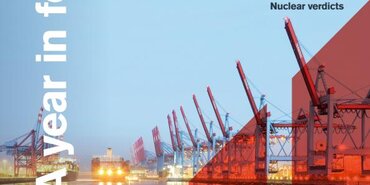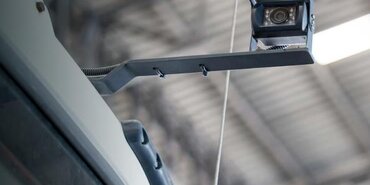Crane safety recommendations
Recommended minimum safety features for quay container cranes
This paper covers the main recommended safety features for quay container cranes that are not specifically described in national or international standards. It aims to inform terminal operators and OEMs about minimum safety features of quay container cranes to support them with retrofit and greenfield projects.
A joint initiative from TT Club, ICHCA International and Port Equipment Manufacturers Association.
Section 1 includes:
1.1 BOOM COLLISIONS
Boom-to-vessel collisions are the single largest cost of quay crane claims. For example, a boom collision several years ago that bent the crane boom took six months and US$2m to repair and caused a further US$6m in lost revenue. See figures 3 & 4 for examples of damage typical to this type of incident. Many cranes have a trip wire boom collision prevention system that leads terminal operators to believe that they are protected from this sort of accident. However, trip wire systems tend to be maintenance-intensive, and depending on the speed of the gantry, can be ineffective in stopping the crane before a collision has occurred. The best proven technologies are electronic sensors or systems that provide coverage for a minimum of two zones, for example warning or/ with slow down and stop signals.
1.2 CRANE COLLAPSES
Quay crane structural integrity issues and crane collapses are not included in the minimum safety features list of this paper as it is not something that is specifically included in crane specifications as it is basically a maintenance issue. However, these issues are highlighted because structural failure is the third biggest insurance claim cost for quay cranes. Not only can this type of equipment failure be very costly in terms of repairs and operational down-time, but it can result in serious accidents and personal injuries.
It is essential for operators of ports and cargo handling facilities to establish and follow a regular schedule of maintenance and thorough examination of all the lifting appliances. Provisions for such examinations are specified in ILO Convention 152 and its accompanying Code of Practice, and together represent the international standard for the port industry. The purpose of a thorough examination is to ensure that cranes can continue to function safely and effectively. The integrity of cranes’ structure is crucial to this.
It is also recommended that an independent examination is always performed when procuring any type of crane. The ILO Convention requires that, prior to commissioning, lifting appliances are tested, and thoroughly examined. It is also recommended that appropriate mechanical and electrical inspections are carried out, during manufacture and commissioning, to check quality and conformance to standards and specifications – beyond any ILO Convention requirement. Once commissioned, a crane should be examined regularly during its operational life regardless of crane type, condition, environmental conditions, etc. Damage resulting from relatively minor impacts, regular heavylifts close or equal to safe working load limits, intensive use and general wear and tear can affect the integrity of a crane’s structure.
Often, such operational issues can arise without anybody being aware of them so regular examinations need to be conducted. Any reported incident should prompt an immediate examination of a crane’s structural integrity. This advice applies not just to quay cranes but equally to fixed and mobile cranes of all types.
1.3 WIND DAMAGE
Wind damage, primarily involving cranes being blown along rails, is the largest preventable weather damage cost. While operating and securing procedures are a significant issue in reducing this type of accident, equipment type and design can reduce such claims. See Figures 5 & 6 for examples of equipment damage caused by wind.
1.4 OTHER COLLISIONS
Other collisions include gantry and hatch cover collisions, spreaders and containers colliding with handrails, crane legs, and other mobile equipment.
1.5 HOIST, WEIGHT, TWISTLOCK, CELL GUIDE ISSUES
Spreaders and cell guides tend to be the most intensively used items of equipment in a terminal and as such require regular inspections and frequent preventative maintenance in accordance with manufacturers’ (or Class) specifications. Recent advances in twistlock load sensing technologies can help mitigate some of these types of incidents. Many of the incidents where containers are stuck in cell guides are the result of poorly loaded containers tipping from the horizontal near the top of cell guides. Twistlock load sensing can detect eccentricity and allow side shifting of the spreader to level the container to prevent jamming. Besides weight and eccentricity measurement, this technology also detects whether all twistlocks have engaged and prevent hoisting if they have failed to do so.
1.6 STACK COLLISIONS
This is where the spreader, or a container under the spreader, collides with another container on the vessel. This can result in one or more containers being knocked from the stack, falling in the water or falling on the quay deck and causing container, cargo and equipment damage and often injuries.
1.7 TWIN TWENTY ISSUE
Accidents commonly occur when two (2) twenty foot containers in a hatch are lifted with the spreader in 40’ mode. When nearing the top of the hatch, the middle ends of the two twenty foot containers risk dropping. This can result in damage to the cell guides, container damage, cargo damage and crane damage. Lengthy operational delays also result, especially if containers become stuck in cell guides.
Documents
Recommended minimum safety features for quay container cranes (1.90 MB) 20/11/2019
- Author
- Staff Author
- Date
- 01/10/2019






